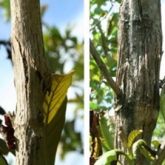Pink disease

Pink disease stem canker on teak showing sunken lesions (left) and bark swelling and splitting (right)
© Queensland Government

Dieback in new foliage (left) and internal decay (right) caused by pink disease cankers on teak branches
© Queensland Government
Pink disease is caused by the fungal organism Erythricium salmonicolor and is found in a wide range of tropical, woody crops.
Symptoms include stem and branch cankers, gum exudation, and swelling or sunken areas on the main stem and branches, as well as cracking or splitting bark and dieback.
Stem canker has been found in commercial teak and African mahogany plantations in northern Queensland.
Scientific name
Other names
- Pink disease of cocoa
- Citrus pink disease
Similar species
- Fusarium solani has also been detected at some infection sites.
Description
- Symptoms often appear at the base of a branch.
- Affected trees may show different forms of the fungus:
- Cobweb stage: a layer of white to pink mycelium develops during wet conditions.
- Pustule stage: pink pustules, around 1mm in diameter appear shortly afterwards.
- Necator stage: orange or red sporing structures develop, usually on the upper surfaces of branches.
- Basidiocarp or pink encrustation stage: cankers may be covered in pinkish fruiting structures, originating at branch forks and extending across the underside of dead and dying branches. Fruiting structures and spores spread in the wind.
Distribution
- Northern Queensland.
- The disease is more common in wet, tropical conditions, although serious damage occurs where the rainfall exceeds 2,000mm per year.
Hosts
Erythricium salmonicolor has a very broad host range, including:
- teak (Tectona grandis)
- African mahogany (Khaya senegalensis)
- tropical, woody crops such as apple, breadfruit, carambola, cashew, citrus, cocoa, coffee, custard apple, durian, jackfruit, macadamia, mango, mangosteen, rambutan, rubber and tea.
Forest red gum (Eucalyptus tereticornis), rose gum (E. grandis) and spotted gum (Corymbia citriodora) are hosts overseas, but no infections in eucalypts have been recorded in Australia.
Damage
- Branches and the main stem swell, have sunken areas or die as a result of girdling.
- Bark splits and cracks.
- Fungus penetrates intact or wounded bark and eventually kills the cambium layer.
- Fungus can also invade the sapwood, causing discolouration and reduced water movement.
- Large-diameter branches and entire trees can ultimately be killed.
- Surveys of teak plantations in northern Queensland suggest susceptibility varies between trees.
Control
- Remove and burn affected branches.
- Application of fungicide can be effective.
Resources and research
- Australian Pesticides and Veterinary Medicines Authority (APVMA)
- Old, KM, Davison, EM, 2000, Canker diseases of Eucalyptus. In PJ Keane, GA Kile, FD Podger, BN Brown (Eds), Diseases and pathogens of eucalypts (pp 241–257), CSIRO Publishing,